- Home
- / Blog
- / Interior Design
9 Principles For Luxury Interior Lighting
05/19/2021
Luxury interior lighting plays a major role in adding to the elegance of a space. Find out the exceptional principles, top features, and tips for incorporating luxury in your interiors through proper lighting design.
Like every other element in a design, luxury interior lighting is an essential aspect in achieving a sophisticated look in luxurious spaces. Lighting serves a great purpose in creating an atmosphere of elegance and class. In luxury interior design, light is more than just an illuminator as luxurious fixtures are also decorative, adding to the aesthetics of the space.
Luxury is associated with glamour, quality, and refinement. Therefore, the skillful selection of suitable lighting fittings to incorporate in your interior lighting designs is crucial in creating a striking impression.
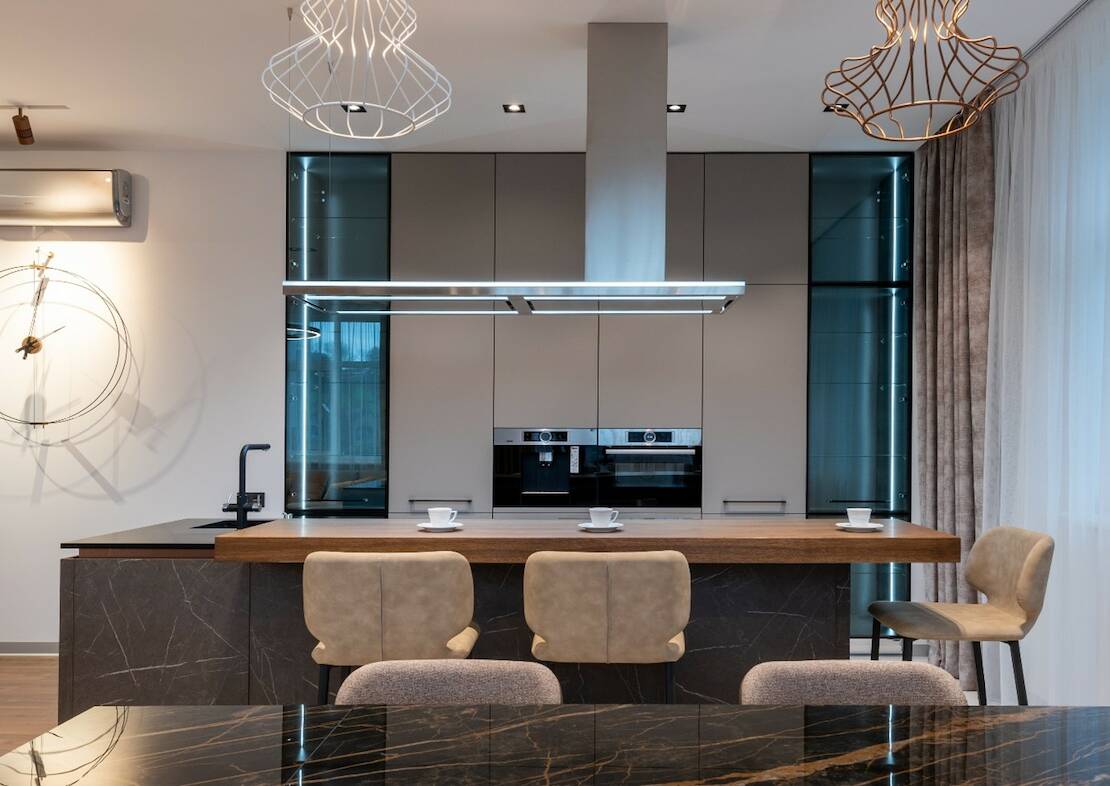
Top Features of Luxury Interior Lighting
What makes for luxury lighting? A highly coordinated and well-thought-through lighting design is a must when it comes to luxury interior design. Using the proper lighting scheme will effectively bring out the desired ambiance of the space. The following are some of the main aspects and guiding principles of luxury lighting that you should incorporate into your design:
1. Material Selection
Luxury interior lighting employs the use of high-quality, refined materials in their fixtures. The use of valuable metals with a sleek and flawless finish is prominent in the designs. Polished metals such as gold, brass, chrome, copper, silver, or stainless steel give the fittings a more futuristic look.

Crystals, precious jewels, and crafted glass coupled with unparalleled craftsmanship also bring in an aspect of affluence and lavishness into the décor. Therefore, luxury lighting incorporates them in the embellishment of the fixtures, to disperse the light, or to create shades for the lighting fixtures.

2. Unique and Customized Pieces
Luxury interior lighting uses uniquely designed lighting fixtures that are exceptional. Handcrafted pieces, artistic fixtures, and customized lighting express affluence in the incorporation of pieces that are not commonly or easily acquirable.
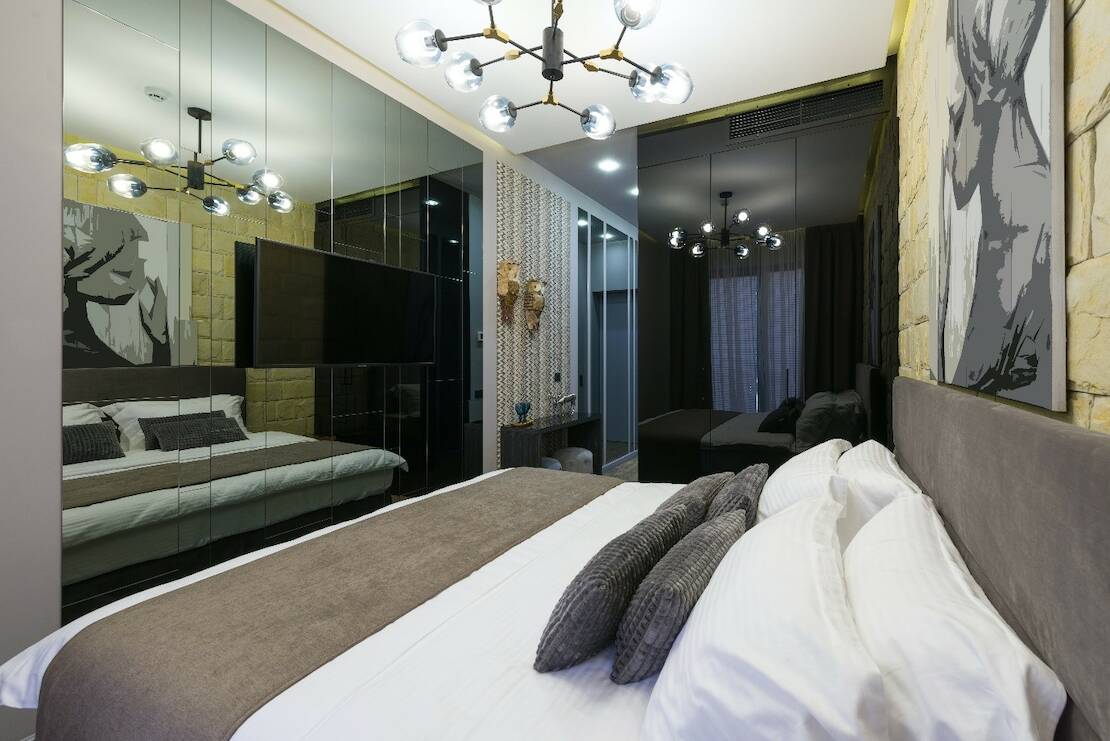
You can opt for sizeable light fixtures with intricate ornate designs in lavish luxurious interiors. Alternatively, use a simple and classic but not plain light fixture for minimalistic and modern elegance. When working on a budget, invest in one-of-a-kind, exclusive, timeless quality pieces, rather than many ordinary, substandard fittings.
3. Aesthetics and Design Style
Illuminance levels and layering are often the first considerations in lighting design. However, in luxury designs, how the fixtures fit into the décor is also a major factor. The choice of the luminaire design thus influences this aspect.

Wood Table Luxury Lamp, Vachtobovich Maxim, 2020, via Pexel
The sophisticated light fixture selected must complement the design style. Whether for a classical, contemporary, modern, minimalistic, cultural, or traditional interior décor, the light fittings and fixtures should be able to seamlessly fit into the design without looking invasive. This creates harmony in the décor, which is a fundamental aspect of light design for home interiors.
4. Ample Use of Natural Daylight
Luxury interior design has a fresh and airy feel in its interior space as a result of the ample use of daylight. Large windows and glazed doors that allow adequate daylight into the rooms characterize luxurious interior architecture.
However, natural daylight varies according to the time of day, site location, climate, and orientation of the building. Therefore, adjustable artificial lighting plays a major role in supplementing the natural daylight to the required illuminance levels of the space.
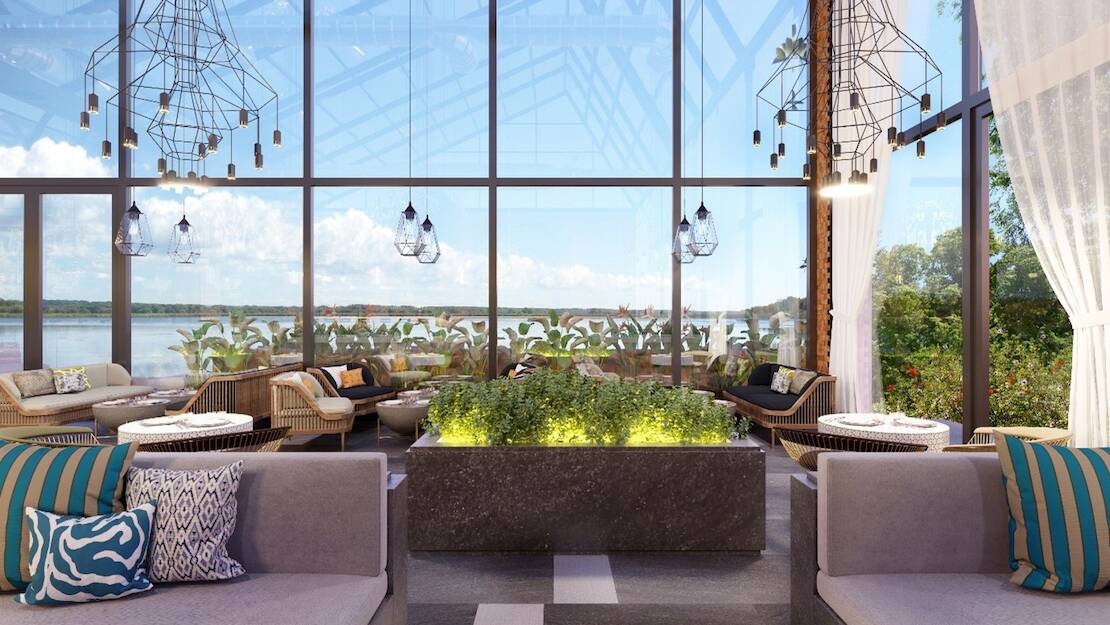
You can simulate the natural daylight in the rooms through the proper selection of the light bulb and lamps used in the lighting design. The correct use of artificial light in accent lighting also affects the mood and experience of the space.
5. Layering of Light
In a luxurious interior design, comfort is key. The same principle applies to visual comfort in lighting design. Having adequate lighting prevents visual fatigue or migraines, and provides just the right amount of illuminance levels in the space.
Luxury interior lighting stands out from the rest through the lavish layering of light in its décor. Ambient lighting generally illuminates the space to the recommended levels. Use uniformly distributed ambient lighting in the interior space to effectively light up every corner of the room.
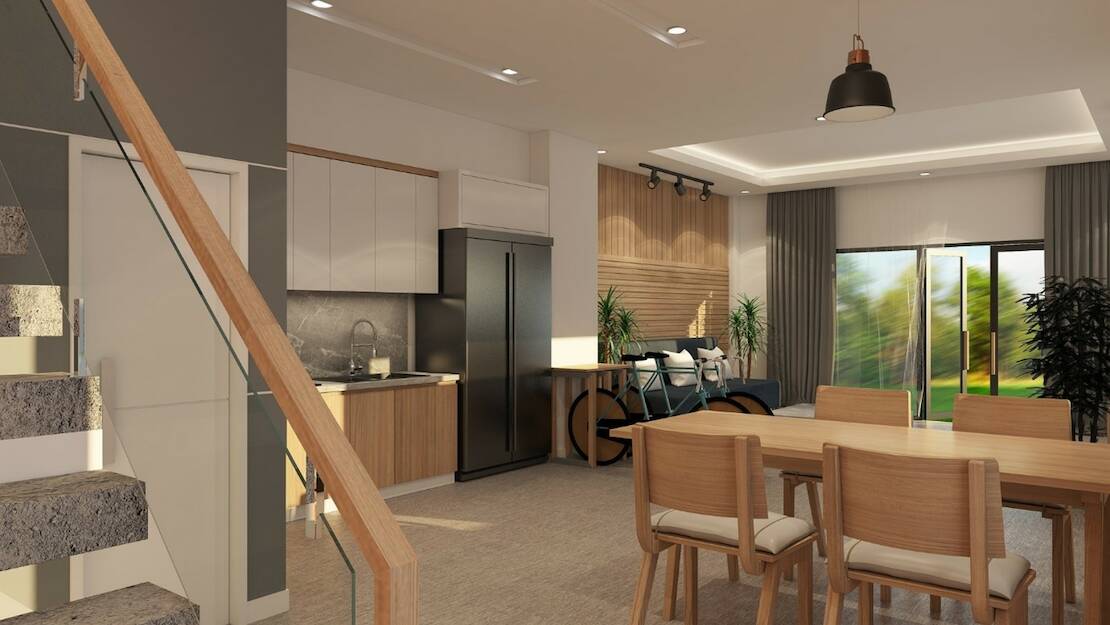
Interior Design Architecture, Khiem Tran, 2017, via Pixabay
Additionally, task lighting provides more functional lighting required to carry out specific intended tasks in the room such as reading. You can add floor lamps and table lamps to your décor for this purpose.
Finally, nothing speaks of luxury better than accent lighting, especially in the art-centric room. Highlight any special features or art in the room through the addition of accent lights. You can also use them as mood light, to create the desired emotional mood in the room. According to an article by Truly, emotional connection is the climax of modern luxury.
Accent lighting can create an intimate as well as an energizing mood in the room, all depending on the lamp selection. It also flexibly gives more room for artistic expression and the creative use of light in the room.
6. Types of Luxury Lighting Fixtures
There are many types of light fittings available in the lighting industry today. Some of the stylish pieces that you can add to your interior space to instantly elevate the décor include ceiling-mounted fixtures, pendant lights, wall sconces, recessed light, track lighting, spotlights, floor & table lamps, downlight, and cove lighting.
Chandeliers have been a major feature when it comes to luxury interior lighting in grand spaces and luxurious hotels. However, for modern spaces, commercial spaces, and smaller rooms, pendant lights are a more common alternative for achieving a similar level of elegance.
Recessed lighting and cove lighting have also become more common with the increased incorporation of false ceilings and drywalls in luxury interiors. While recessed lighting provides a more direct ambient light, cove lighting, especially with LED strips, offers an indirect lighting solution.
Beyond floor lamps and table lamps, also add task lighting to the otherwise neglected areas such as the staircase and direct mount lighting below the kitchen cabinets and in the shelves. For wall art, add accent lighting using wall sconces and some art lighting through the use of track lighting and spot lighting. Furthermore, the backlighting of mirrors, large pictures, and artworks is all the rage when it comes to luxury lighting.
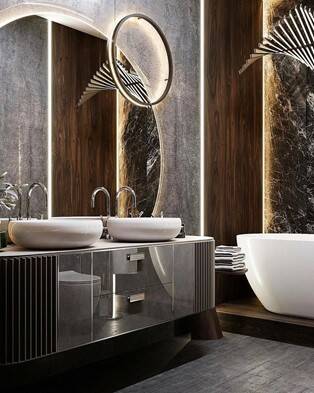
Mirarti Design, Maison Valentina, 2020, via Pinterest
Perfect Picture Lights has a variety of products and lighting fixtures within this range, flawlessly designed and handcrafted for luxury interiors. They also customize the finishes as desired to fit into any interior design style.
7. Color Use
Modern luxury employs the use of neutral color palettes in its interior design. Apart from the metallic and glass materials, painted finishes can adopt whites, greys, blacks, and other neutral colors.
The color temperature of the lights source is also key in luxury design. The incorporation of gradual change of tone creates a cozy atmosphere, as compared to highly contrasting lights that may cause visual fatigue. Warmer colors create a more relaxed and intimate ambiance, while white and cool lights are mentally stimulating and invigorating.
8. Flattering Light
Luxury interior design uses light to accentuate the features of what matters most in the space. For restaurants, the lighting must be flattering to the people in the room. Similarly, art lighting is specifically chosen to complement the pictures and art in galleries.
There is no one-light-fits-all solution when it comes to luxury lighting. A proper lighting design illuminates every room differently according to its functions, requirements, and envisioned mood. Highlight the main features in a room, ensuring that the lighting makes everything look better.

9. Balanced use of Direct and Indirect Lighting
For visual comfort, luxury interior lighting uses a good balance of direct and indirect lighting in the space. For direct lighting, ambient lighting fixtures with diffusing panels minimize glare by scattering the light. This creates softer lighting and minimizes crisp shadows. Indirect Lighting is also incorporated in the interior decoration lights design by the use of uplighting and cove lighting.
In Conclusion
To master the art of luxury interior lighting, it is important to study and learn from the works of some of the best interior designers. The list by LuxDeco, of the top modern interior designers of our era, is a great place to start. Identify the most suitable luxury lighting fittings for your design style, and then layer them to create an elegant ambiance in the space. Browse through handcrafted collections of luxury lighting fixtures to invest in your first piece of quality lighting.
_______________________________________________________________________________________________________
 Winny Okoth is a practicing Construction Project Manager and Interior Designer. She is also currently pursuing her Master’s Degree in Construction Project Management. Winny Okoth has a great passion for every form of design and has the mastery of principles of design, as well as 3D visualizations skills for architectural and interior design renders.
Winny Okoth is a practicing Construction Project Manager and Interior Designer. She is also currently pursuing her Master’s Degree in Construction Project Management. Winny Okoth has a great passion for every form of design and has the mastery of principles of design, as well as 3D visualizations skills for architectural and interior design renders.


